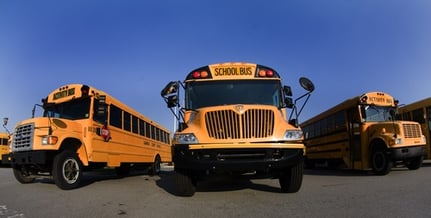15 Tips On How To Prepare For A Bus Route Change
published on September 20, 2022 by Sonia Mastros
bus routing software, bus routing, bus route optimization, school bus routing software, school bus driver shortage, inefficient routes, outdated routes, inaccurate routes, route efficiency, state reporting, re-routing, bus shortages
 There are few responsibilities facing a school district which are larger, more important, or more potentially hazardous than your need to transport hundreds or thousands of students safely, every day.
There are few responsibilities facing a school district which are larger, more important, or more potentially hazardous than your need to transport hundreds or thousands of students safely, every day.
Your bus routes ultimately determine the effectiveness of your student transportation system. Poorly-optimized routes waste money, waste time, and potentially even expose students to unnecessary dangers along the way.
Whether it's doing a full bus route revision over Summer Vacation, or simply adjusting your routes in response to student migration, well-planned bus routes are a necessity for safely transporting your students.
So, we've got 15 tips - broken up into three sections - to help you prepare and implement bus routing changes quickly, effectively, and safely!
Before The Change
1) Verify All Student Information
Before you even think about updating your maps, you need to be working off reliable student data. Your first step in any revision is ensuring you have accurate and up-to-date information for all your students.
2) Take Note of Special Cases
Are there any students who will need extra accommodations? Students with special needs and children of divorces with shared custody often require special arrangements. Have a list of these students ready when making your plans.
3) Update Your Maps
As with your students, proper maps are a requirement for bus route planning. Ensure your maps are current, including any planned construction or active road blocks.
4) Contact the City About Planned Changes
Look ahead! Your local city planning office will be happy to warn you about planned developments or street closures, which can be invaluable in planning routes which last an entire school year.
5) Obtain Route Optimization Software.
At the end of the day, trying to plan maps using strings and pushpins is just too inefficient. A good bus routing software suite can take a months-long job and do it in a matter of minutes.
Making The Change
1) Add "Threat Zones"
Take a serious look at the crime rates in your town. Are there areas with high gang activity or with registered sex offenders? You likely don't want your buses anywhere near these areas.
2) Run Multiple Hypothetical Scenarios
With a good bus routing software system, you have plenty of options for how to lay out your routes. Since you can create an infinite number of scenarios, try different variations of roads and numbers of routes to see what results save you the most time and money.
3) Try Different Bus Stop Walking Distances
One of the biggest influences on how many buses you run, and how often they stop, is the distance they have to be from a student's home. Try changing up how far a student has to walk, and find a balance between safety and cost-savings.
4) Transmit Updates to Your Drivers ASAP
Your drivers need advance warning. They shouldn't find out about a route change when they sit down on the bus. Make sure your drivers are among the first to hear about your changes.
5) Add GPS Units to Your Buses
While not a requirement, GPS units in your buses will vastly simplify on-road operations, as well as ensuring your drivers always know the right route to drive. GPS systems basically mean you will never lose track of a bus again, even for a few minutes.
After The Change
1) Contact All Affected Parents
Along with your drivers, parents should be among the first people you inform. Post cards, notes, emails, or phone calls should be made to any parent who will be affected by your changes.
2) Produce a Full Set of Paper Maps
Even though your mapping software keeps electronic backups, you'll still want a set of paper maps to refer to. They're useful in emergencies, such as power failure, as well as for ensuring your paper records remain current.
3) Track Your Mileage and Fuel Usage
There's a limit to how much real-world information a mapping system can hold. If you track your buses' mileage and fuel costs - which is made especially simple with GPS - you can often make small adjustments to your routes that save time or money based on real-world performance.
4) Keep Producing New Hypothetical Routes
Similarly, there's no reason not to keep playing around with your bus routing. Whenever anything changes, run a few new scenarios and see if you can get better results.
5) Consider Using NFC-Enabled Student IDs
While a significant investment, an NFC tracking system makes it simple to ensure every student gets on the right bus, and gets off at the right stop, every time. When you're making large-scale changes to your bus system, this can vastly reduce confusion and "lost" children getting onto the wrong bus. This system can also track student ridership to ensure buses are not going out of their way to pick up students that never ride.
Finally, for more tips on how to optimize your routes and get the most from bus routing software, please don't hesitate to contact Orbit Software, makers of BusBoss for the best in modern school bus management systems!
What do you think? Is there anything important that we missed? Let us know in the comments below!



